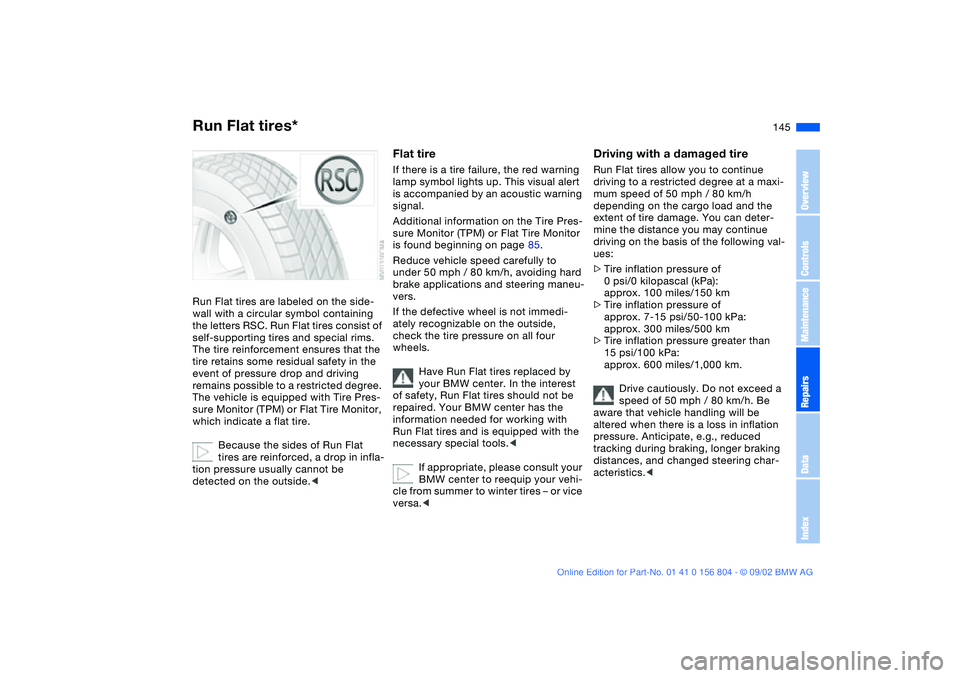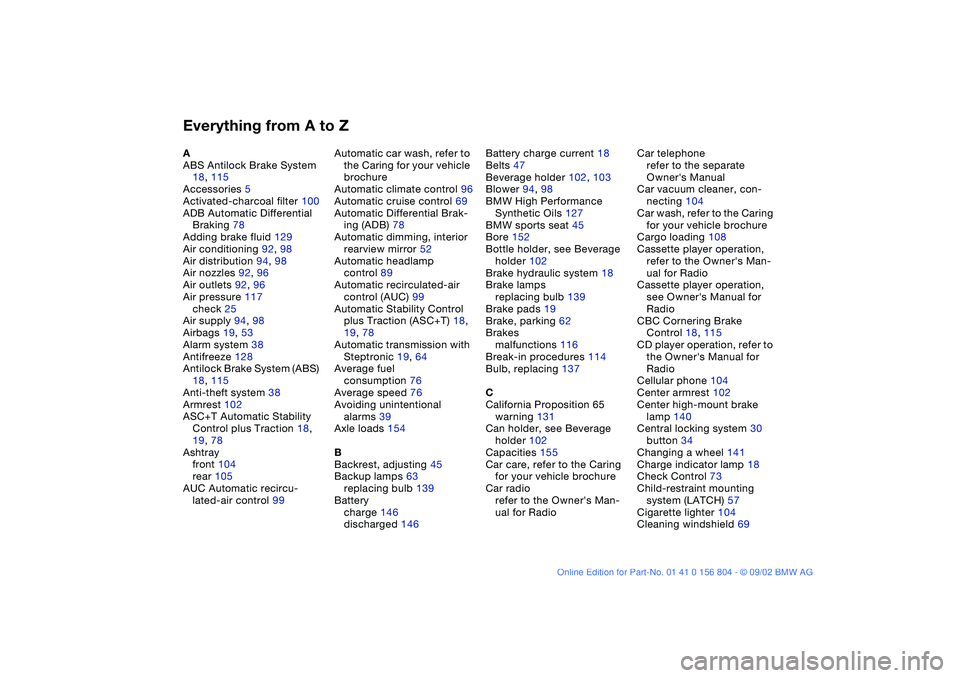2003 BMW 330I warning light
[x] Cancel search: warning lightPage 145 of 166

145
Run Flat tires*Run Flat tires are labeled on the side-
wall with a circular symbol containing
the letters RSC. Run Flat tires consist of
self-supporting tires and special rims.
The tire reinforcement ensures that the
tire retains some residual safety in the
event of pressure drop and driving
remains possible to a restricted degree.
The vehicle is equipped with Tire Pres-
sure Monitor (TPM) or Flat Tire Monitor,
which indicate a flat tire.
Because the sides of Run Flat
tires are reinforced, a drop in infla-
tion pressure usually cannot be
detected on the outside.<
Flat tireIf there is a tire failure, the red warning
lamp symbol lights up. This visual alert
is accompanied by an acoustic warning
signal.
Additional information on the Tire Pres-
sure Monitor (TPM) or Flat Tire Monitor
is found beginning on page 85.
Reduce vehicle speed carefully to
under 50 mph / 80 km/h, avoiding hard
brake applications and steering maneu-
vers.
If the defective wheel is not immedi-
ately recognizable on the outside,
check the tire pressure on all four
wheels.
Have Run Flat tires replaced by
your BMW center. In the interest
of safety, Run Flat tires should not be
repaired. Your BMW center has the
information needed for working with
Run Flat tires and is equipped with the
necessary special tools.<
If appropriate, please consult your
BMW center to reequip your vehi-
cle from summer to winter tires – or vice
versa.<
Driving with a damaged tireRun Flat tires allow you to continue
driving to a restricted degree at a maxi-
mum speed of 50 mph / 80 km/h
depending on the cargo load and the
extent of tire damage. You can deter-
mine the distance you may continue
driving on the basis of the following val-
ues:
>Tire inflation pressure of
0 psi/0 kilopascal (kPa):
approx. 100 miles/150 km
>Tire inflation pressure of
approx. 7-15 psi/50-100 kPa:
approx. 300 miles/500 km
>Tire inflation pressure greater than
15 psi/100 kPa:
approx. 600 miles/1,000 km.
Drive cautiously. Do not exceed a
speed of 50 mph / 80 km/h. Be
aware that vehicle handling will be
altered when there is a loss in inflation
pressure. Anticipate, e.g., reduced
tracking during braking, longer braking
distances, and changed steering char-
acteristics.<
OverviewControlsMaintenanceRepairsDataIndex
Page 147 of 166

147 Giving and receiving assistance
Jump-startingWhen your battery is discharged you
can use two jumper cables to start your
vehicle with power from the battery in a
second vehicle. You can also use the
same method to help start another
vehicle. Only use jumper cables with
fully insulated handles on the terminal
clamps.
Do not touch high-voltage wiring
and cables on a running engine.
Contact with components carrying high
voltage can be harmful or fatal. Care-
fully observe the following instructions
to avoid personal injury and/or damage
to one or both vehicles.<
1. The battery in the support vehicle
must also be rated at 12 volts. This
information is provided on the battery
label
2. Stop the engine of the support vehi-
cle and switch off all electrical com-
ponents in both vehicles – except for
the hazard warning flashers of the
support vehicle
3. Make absolutely certain that there is
no contact between the bodywork of
the two vehicles – short circuit haz-
ard
4. The auxiliary jump-starting terminal
located in your BMW's engine com-
partment acts as the positive battery
terminal. The cover of this auxiliary
terminal is marked with a + sign.
Remove by pulling the tab – see
arrow 1.
Start by connecting the jumper cable
from the positive terminal of the dis-
charged battery to the positive termi-
nal of the support battery
5. Then connect the negative terminals
with the other jumper cable. First
connect one end to the negative bat-
tery terminal or to a suitable grand on
the support vehicle. Then connect
the other end to the negative battery
terminal or a suitable ground on the
vehicle being started.
Your BMW is equipped with a special
nut for this purpose – see arrow 2
Always adhere to this sequence
when connecting jumper cables;
failure to observe this procedure can
lead to sparks at the battery terminals
and pose an injury hazard.<
6. Start the engine of the support vehi-
cle and let it run for several minutes
at a slightly elevated engine idle
speed
7. Start the engine of the other vehicle
as usual. If the first start attempt is
not successful, wait a few minutes
before another attempt in order to
allow the discharged battery to
recharge
8. Before disconnecting the jumper
cables, let the engines run for a few
minutes
9. Then disconnect the jumper cables
in reverse sequence.
Depending on the cause of the fault,
have the battery checked and
recharged by your BMW center.
OverviewControlsMaintenanceRepairsDataIndex
Page 158 of 166

Everything from A to ZA
ABS Antilock Brake System
18, 115
Accessories 5
Activated-charcoal filter 100
ADB Automatic Differential
Braking 78
Adding brake fluid 129
Air conditioning 92, 98
Air distribution 94, 98
Air nozzles 92, 96
Air outlets 92, 96
Air pressure 117
check 25
Air supply 94, 98
Airbags 19, 53
Alarm system 38
Antifreeze 128
Antilock Brake System (ABS)
18, 115
Anti-theft system 38
Armrest 102
ASC+T Automatic Stability
Control plus Traction 18,
19, 78
Ashtray
front 104
rear 105
AUC Automatic recircu-
lated-air control 99Automatic car wash, refer to
the Caring for your vehicle
brochure
Automatic climate control 96
Automatic cruise control 69
Automatic Differential Brak-
ing (ADB) 78
Automatic dimming, interior
rearview mirror 52
Automatic headlamp
control 89
Automatic recirculated-air
control (AUC) 99
Automatic Stability Control
plus Traction (ASC+T) 18,
19, 78
Automatic transmission with
Steptronic 19, 64
Average fuel
consumption 76
Average speed 76
Avoiding unintentional
alarms 39
Axle loads 154
B
Backrest, adjusting 45
Backup lamps 63
replacing bulb 139
Battery
charge 146
discharged 146Battery charge current 18
Belts 47
Beverage holder 102, 103
Blower 94, 98
BMW High Performance
Synthetic Oils 127
BMW sports seat 45
Bore 152
Bottle holder, see Beverage
holder 102
Brake hydraulic system 18
Brake lamps
replacing bulb 139
Brake pads 19
Brake, parking 62
Brakes
malfunctions 116
Break-in procedures 114
Bulb, replacing 137
C
California Proposition 65
warning 131
Can holder, see Beverage
holder 102
Capacities 155
Car care, refer to the Caring
for your vehicle brochure
Car radio
refer to the Owner's Man-
ual for RadioCar telephone
refer to the separate
Owner's Manual
Car vacuum cleaner, con-
necting 104
Car wash, refer to the Caring
for your vehicle brochure
Cargo loading 108
Cassette player operation,
refer to the Owner's Man-
ual for Radio
Cassette player operation,
see Owner's Manual for
Radio
CBC Cornering Brake
Control 18, 115
CD player operation, refer to
the Owner's Manual for
Radio
Cellular phone 104
Center armrest 102
Center high-mount brake
lamp 140
Central locking system 30
button 34
Changing a wheel 141
Charge indicator lamp 18
Check Control 73
Child-restraint mounting
system (LATCH) 57
Cigarette lighter 104
Cleaning windshield 69
Page 159 of 166

Everything from A to Z
159
Clock 74
setting, refer also to the
radio or onboard com-
puter Owner's Manual
Cockpit 14
Code, refer to the Owner's
Manual for Radio
Coin box 102
Compartments 102
Compression ratio 152
Computer 75
Condensation, removing
from windows 95, 98
Consumption 76
display 72
Coolant 128, 155
Cooling system 155
Copyright 4
Cornering Brake Control
(CBC) 18, 115
Cruise control 69
Cup holder, see Beverage
holder 102
Curb weight 154
Cushion height 153
D
Data
dimensions 153
engine 152
technical 152
weights 154Daytime driving lamps 89
DBC Dynamic Brake
Control 115
Defrost position 95, 98
Defrosting
rear window 94, 99
windows 95, 98
Digital clock 74
Dimensions 153
Dipstick, engine oil 126
Displacement 152
Display lighting 90
Displays 16
Distance warning 77
Divided rear backrest 106
Door key 30
Door lock buttons 34
Doors
emergency operation 33
unlocking and locking 31
Driving notes 115
DSC Dynamic Stability
Control 18, 19, 80
DTC Dynamic Traction
Control 80
Dynamic Brake Control
(DBC) 115
Dynamic Stability Control
(DSC) 18, 19, 80
Dynamic Traction Control
(DTC) 80E
Electric power windows 40
Electrical accessories, fail-
ure 146
Electrical malfunction
fuel filler door 24
sliding/tilt sunroof 43
Emergency operation
doors 33
fuel filler door 24
sliding/tilt sunroof 43
Emergency release
luggage compartment
lid 37
Emissions, minimum, refer
to Energy control 71
Energy control 71
Engine
starting 60
switching off 62
Engine compartment 124
Engine coolant 155
adding 128
temperature gauge 72
Engine data 152Engine oil
adding 126
capacity 155
consumption 126
pressure 18
quality 127
types 127
viscosity 127
Engine oil level 19
check 126
Engine speed 152
Environmentally-friendly
driving, refer to Energy
control 71
Exterior mirrors 51
Eyelet, towing 148
F
Failure messages 73
False alarm, avoiding 39
Fault displays 73
First-aid kit 23
Flashlight 102
Flat tire 117, 141
Flat Tire Monitor 86
Fog lamps 91
Folding rear backrest 106
Follow me home lamps 89
Front fog lamps 91
Front seat adjustment 44
Frost protection
radiator 128
OverviewControlsMaintenanceRepairsDataIndex
Page 160 of 166

Everything from A to ZFuel consumption 76
display 72
Fuel economy, refer to
Energy control 71
Fuel filler door 24
release following an elec-
trical malfunction 24
Fuel gauge 72
Fuel specifications 25
Fuel tank capacity 155
Fuel tank display 72
Fuel tank gauge 72
Fuel-injection system 152
Fuses, replacing 146
G
Gasoline 25
Gasoline gauge 72
Glove compartment 101
Grills 92, 96
Gross vehicle weight 154
H
Hands-free system 104
Harman Kardon premium
sound system 101
Hazard warning flashers 14
Hazard warning triangle 23
HDC Hill Descent Control 84
Head airbags 53
Head restraints 47
Headlamp flasher 90Headlamp washer system
126, 155
Headlamps 89
automatic control 89
Heated seats 50
Heating and ventilation 96
Heavy loads 108
High beams 21, 67, 90
replacing bulb 137
Hill Descent Control
(HDC) 84
Holder for
beverages 102
litter bag 103
Hood release 122
Horn 14
Hydraulic brake assistant,
see DBC
Hydroplaning 115, 117
I
Ice warning 75
Icy roads 75
Ignition key 30
Ignition lock 60
Imprint 4
Indicator lamps 18
Inflation pressure 25, 117
monitoring 85
INSPECTION 73
Instrument cluster 16
Instrument lighting 90Instrument panel 14, 16
Interface socket for onboard
diagnostics 131
Interior lamps 32, 91
remote control 32
Interior motion sensor 38
switching off 39
Interior rearview mirror 52
automatic dimming
feature 52
Interlock 60
Intermittent mode 68
J
Jack 141
Jump-starting 147
K
Key Memory 59
Keys 30
with remote control 30
L
Lamp, replacing 137
Lashing fittings 109
LATCH child-restraint
mounting system 57
Length 153
License plate lamp
replacing bulb 141
Light switch 89
Lighter 104LIGHTS ON warning 89
Litter bag holder 103
Load-securing devices 109
Lock, steering wheel 60
Low beams 89
automatic 89
replacing bulb 137
Lug wrench 141
Luggage compartment 35
capacity 154
floor mat 38
floor panel 37
lighting 35
Luggage compartment lid 35
emergency operation 35
emergency release 37
remote control 32
securing separately 35
Luggage rack 110
Lumbar support 46
M
M+S tires 120
Maintenance 73, 130
Malfunction displays 73
Manual transmission 63
MC operation, refer to the
Owner's Manual for Radio
MD operation, refer to the
Owner's Manual for Radio
Memory 49
Memory settings 59